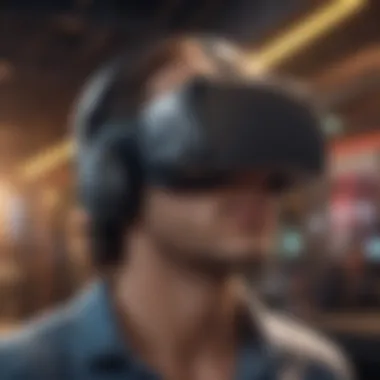Understanding the Price Dynamics of Virtual Reality


Intro
The landscape of virtual reality (VR) is evolving rapidly. This article examines the pricing dynamics associated with VR technologies, exploring various aspects that influence costs. Understanding these price dynamics is crucial for students, researchers, and professionals in this field. A deep dive into this topic reveals the intricate relationship between market forces, consumer demands, and technological innovation. By analyzing historical data and current trends, we can paint a clearer picture of what to expect in the future.
Key Concepts
Definition of the Main Idea
Virtual reality encompasses various technologies that create immersive experiences for users. This includes hardware like headsets and controllers and software that powers applications and games. The pricing of these components is not merely a reflection of manufacturing costs, but rather a complex interplay of multiple market factors.
Overview of Scientific Principles
At its core, pricing in VR hinges on supply and demand principles, the cost of production, and the perceived value by the consumer. Several scientific concepts influence price formation:
- Cost of Materials: The quality and type of materials used in VR hardware.
- Technological Advancement: Innovations can either lower production costs or create higher-priced premium products.
- Market Competition: The level of competition affects pricing strategies, directly impacting consumer choices.
Current Research Trends
Recent Studies and Findings
Recent studies indicate significant variance in pricing across different VR products. Research demonstrates that while some companies like Oculus offer more affordable solutions, others like Valve’s Index target higher-end users. Understanding these variability points can assist consumers in making informed decisions.
Significant Breakthroughs in the Field
Key breakthroughs include developments in display technology, which enhance user experience. Improvements in motion tracking and haptic feedback also affect product pricing. As these technologies become more mainstream, the overall cost of VR setups is likely to change.
"The future of VR pricing will depend largely on both consumer acceptance and technological integration."
"The future of VR pricing will depend largely on both consumer acceptance and technological integration."
Ending
The pricing dynamics in virtual reality are intricate and multifaceted. This article provides a framework for understanding the driving factors, offering valuable insights for anyone involved in or studying this vibrant field.
Prelude to Virtual Reality Pricing
Understanding the pricing dynamics of virtual reality (VR) is essential for stakeholders across various sectors. As VR technology continues to evolve, the costs associated with it reflect a mix of factors, including development, production, and consumer demand. This section aims to lay the groundwork for a deeper analysis of how pricing in VR is determined and its implications for both producers and consumers.
Defining Virtual Reality
Virtual reality refers to a simulated experience that can mimic or differ from the real world. It uses technology such as headsets and motion trackers to create immersive environments. There are various applications for VR, ranging from gaming and entertainment to education and medical training. As technology advances, what may seem like a luxury today may quickly transition into a standard tool in various fields. Thus, understanding its definition and use is fundamental to discussing its pricing structure.
Importance of Pricing in Technology Adoption
Pricing plays a significant role in the adoption of any technology, and VR is no exception. The balance between cost and perceived value is crucial for potential buyers. High prices may deter consumers, while low prices could suggest lower quality or less advanced technology.
Key considerations include:
- Consumer Perception: How consumers perceive the value of VR technology can influence their willingness to invest.
- Market Competition: The presence of multiple brands and products can lead to competitive pricing, affecting overall market dynamics.
- Investment Recovery: For businesses, the initial investment in VR technology must align with expected returns. Companies must carefully analyze whether high development costs can translate into profitable outcomes.
"The willingness to pay often depends on the perceived utility of the technology in enhancing user experience or solving specific problems."
"The willingness to pay often depends on the perceived utility of the technology in enhancing user experience or solving specific problems."
Historical Context of VR Pricing
Understanding the historical context of virtual reality (VR) pricing is essential for comprehending the current landscape of VR technology. This section examines how pricing has evolved over the years and highlights important factors that contributed to its development. The historical perspective sheds light on how past innovations and consumer responses have shaped current VR pricing trends and frameworks.
The Evolution of VR Technology and Costs
Throughout its history, virtual reality has undergone significant changes in both technology and cost structures. Early forms of VR appeared in the 1960s, involving heavy equipment and limited applications. As this technology evolved, so did its accessibility and affordability. Predictably, initial VR systems were prohibitively expensive, often limited to military and research institutions.
In the late 1980s, products like the Virtuality Group's arcade systems emerged, making VR available to the public. These systems, though commercially viable for entertainment, still involved considerable investment, costing thousands of dollars. This limited participation of the general consumer compared to today’s experiences.
In recent years, advancements in technology and production processes have led to a significant decrease in costs. The introduction of consumer-grade headsets, such as the Oculus Rift, HTC Vive, and PlayStation VR, revolutionized the market by bringing more affordable VR solutions to consumers. By leveraging smaller, lighter components and software-driven experiences, manufacturers have optimized costs while enhancing performance.
Early VR Systems and Their Price Points
Early VR systems predominantly carried steep price tags that reflected their complexity and novelty. Products like the NASA-developed Virtuality system could cost roughly $50,000 or more—a price that limited its use to specialized sectors. Comparatively, today's VR headsets can be purchased for a fraction of that cost, often under $500. This price reduction has made VR more accessible to the average consumer.
The entry of technology giants such as Facebook and Sony played a pivotal role in lowering prices. Facebook’s acquisition of Oculus in 2014 signified a commitment to making VR mainstream. The release of the Oculus Quest, a standalone headset priced around $400, marked a turning point in the expectations around affordability in VR.


Current Market Dynamics
The dynamics of the current virtual reality market hold significant relevance in understanding price structures and trends associated with VR technologies. These dynamics are shaped by various elements, including competition among major players, consumer demands, and shifts in technology. Companies strive to innovate, not only to enhance user experience but also to secure their standing in a volatile market.
The importance of analyzing current market dynamics lies in its ability to unveil the factors that can influence pricing strategies dramatically. As businesses continue to compete for market share and consumer attention, their approaches to pricing become pivotal. Moreover, price sensitivity among consumers often shifts based on new technological advancements and product availability.
Understanding these factors is essential for stakeholders in the industry, whether they are developers, marketers, or investors. Price levels directly affect consumer adoption rates, and an insightful grasp of market dynamics can foster strategic decisions that resonate with target audiences.
Major Players in the VR Market
Several companies dominate the VR landscape, each contributing to the market dynamics in various ways. Meta (formerly Facebook) plays a crucial role with its Oculus product line, which offers both hardware and a platform for software distribution. This company has heavily invested in promoting VR technologies, aiming to enhance accessibility for users.
Sony, with its PlayStation VR, has integrated virtual reality into console gaming. Their pricing strategies are closely tied to consumer expectations in the gaming sector, influencing how other companies may set their prices.
Other notable players include HTC, Valve, and Microsoft, with their unique offerings catering to different market segments. The presence of these major companies shapes competition, ultimately impacting consumer choices and pricing trends.
Comparative Pricing of Leading VR Products
When assessing the pricing of leading VR products, one finds a range of price points reflecting the diversity of features and target audiences.
- Oculus Quest 2: Priced competitively, making it accessible for casual users. Features a standalone setup, allowing for ease of use without external hardware.
- Sony's PlayStation VR: Generally marketed to gamers, thus aligns its pricing with positioning in the gaming community.
- Valve Index: Positioned at a higher price tier due to advanced features, catering to dedicated gaming enthusiasts.
The prices differ significantly due to the technologies utilized and the target markets these devices serve. Recent trends indicate consumers have become more price-sensitive as alternatives become more available, impacting the strategies of leading brands.
"Pricing strategies must adapt to consumer expectations and technological advancements to remain competitive in the VR market."
"Pricing strategies must adapt to consumer expectations and technological advancements to remain competitive in the VR market."
As the virtual reality landscape evolves, continual assessments of product pricing will be crucial for both consumers making purchasing decisions and companies developing their product lines. By understanding the comparative pricing among major VR products, one can appreciate how market dynamics influence overall consumer engagement.
Factors Influencing VR Hardware Prices
Pricing strategies for virtual reality (VR) hardware are shaped by numerous factors that intertwine technological demands and market realities. Understanding these influences helps stakeholders navigate the VR landscape effectively. A comprehensive analysis reveals not only the immediate costs associated with production but also the longer-term implications of these prices on adoption and innovation.
Technological Advancements and Their Impact
The evolution of technology plays a critical role in determining VR hardware prices. As companies innovate, they introduce more sophisticated features. Enhanced graphics, better sensors, and improved user interfaces often elevate manufacturing costs. Likewise, new technologies can create economies of scale. When production techniques become more efficient, it typically reduces costs.
Moreover, advancements often lead to broader competition, making various prices available in the market. For instance, the introduction of standalone headsets has diversified price ranges, bringing down costs for entry-level devices while driving up prices for high-end models.
As a result, consumers are presented with a wider array of options. The availability of budget options bridges the gap between casual users and enthusiasts, inviting greater market participation. This aspect fosters innovation as companies strive to differentiate their products, utilizing pricing as a competitive strategy.
Supply Chain Dynamics
Another influential factor is the supply chain dynamics that underpin VR hardware production. The processes involved in sourcing materials, manufacturing components, and distributing products can impact pricing significantly. For example, the global semiconductor shortage had severe implications for many tech industries, including VR. Higher production costs because of limited component availability translated into elevated prices for consumers.
Additionally, geographic variations in production and logistics can create disparate pricing structures. Companies often face different costs based on local labor markets, tariffs, and regulatory environments. Effective supply chain management can mitigate some of these costs, offering a competitive edge.
In summary, the interplay of technological advancements and supply chain dynamics paints a complex picture of VR hardware pricing. Companies must constantly adjust to changes in technology and market conditions, making strategic decisions that can affect the sustainability of their business model. Understanding these factors will empower stakeholders to make informed decisions as they engage with the VR market.
Key Point: The price of VR hardware does not just reflect the product's value; it embodies the intricate relationship between technology, supply chains, and market forces.
Key Point: The price of VR hardware does not just reflect the product's value; it embodies the intricate relationship between technology, supply chains, and market forces.
Software Development Costs in VR
Software development costs in virtual reality (VR) represent a significant portion of the overall expenses associated with creating immersive experiences. These costs can vary widely based on many elements, including the complexity of the software, the technology used, and the size of the development team. Understanding these costs is essential for businesses and individuals investing in VR, as they can directly impact the product's marketability and sustainability.
Investment in Content Creation
Creating compelling content for VR is not just about programming. It involves a multitude of disciplines, from graphic design to storytelling. An investment in content creation is crucial, as high-quality experiences will likely attract more users and ensure better retention.
- Cost of Talent: Skilled professionals, including artists, writers, and developers, come at a premium. Hiring a talented team can dramatically increase initial investments.
- Technology and Tools: Developers must use specific software and hardware, such as game engines like Unity or Unreal Engine. The licensing costs for these tools may add to the overall budget.
- Prototyping and Testing: Creating a VR experience often requires extensive testing to ensure usability and engagement. The costs of prototyping and subsequent iterations can accumulate quickly.
Ultimately, the decisions made during the content creation phase have lasting implications on user satisfaction and return on investment. Thus, careful planning and analysis of costs are necessary to maximize the potential of VR applications.
Analysis of Pricing Models for VR Applications
Different pricing models exist for VR applications, each with its strengths and weaknesses. Understanding these pricing strategies is key for businesses aiming to enter the VR market.
- Premium Pricing: This model is straightforward. Users pay a one-time fee to access a complete VR experience. While this can generate immediate revenue, it may limit the audience willing to pay upfront without prior experience or guarantees of value.
- Freemium Model: This approach offers a basic version of the application for free, with the option to purchase additional features or content. This model can entice users to try before they decide to invest further.
- Subscription Services: With the rise of content subscription models, charging monthly or yearly fees for access to a library of VR content is becoming more popular. This can create a steady stream of revenue but relies on continuously adding value to retain subscribers.
Each pricing model has distinct implications for cost recovery and long-term financial viability. Companies must choose wisely based on target audiences, market demand, and the uniqueness of their offering.


"Understanding the dynamics of software development costs and pricing models can significantly influence the success of VR applications in the competitive marketplace."
"Understanding the dynamics of software development costs and pricing models can significantly influence the success of VR applications in the competitive marketplace."
By examining these aspects, developers and investors can better navigate the financial landscape of virtual reality, ensuring their projects align with both consumer expectations and economic realities.
Consumer Expectations and Price Sensitivity
Understanding the dynamics of consumer expectations and price sensitivity is crucial in the realm of virtual reality. Consumers are faced with a variety of options when selecting VR products, each with different features and price tags. This complexity forces manufacturers and developers to carefully consider how pricing strategies align with the expectations of their target audience. When consumers perceive value in a product, they are more likely to make a purchase, even at a higher price point. Conversely, if a product does not meet their expectations regarding quality or experience, price sensitivity can become a major barrier.
- Consumer Expectations:
- Price Sensitivity:
- Quality of Experience: As virtual reality technology evolves, consumers expect increasingly immersive and engaging experiences. They seek out systems that provide high-resolution graphics, low latency, and intuitive interfaces. This expectation sets a benchmark for manufacturers. If a product's performance does not justify its price, it risks losing market traction.
- Content Availability: The library of games and applications available for a VR headset significantly impacts consumer decisions. A system may be priced attractively, but if it lacks compelling content, it may not meet consumer expectations.
- Budget Constraints: Many potential users are hesitant when it comes to VR because it often requires a significant investment. The costs for hardware and software can add up quickly, leading to increased price sensitivity. Potential buyers must assess whether a particular VR system is worth the investment compared to other entertainment options.
- Competition: When multiple brands offer similar products, consumer price sensitivity becomes pronounced. In a competitive market, consumers will compare features and prices, seeking the best value for their money. Companies often need to adjust prices or offer incentives to capture market share.
"In this crowded market, understanding consumer expectations can provide a crucial edge in product development and marketing strategies."
"In this crowded market, understanding consumer expectations can provide a crucial edge in product development and marketing strategies."
Understanding the Target Audience
Identifying the target audience is vital for any product development strategy, especially in a niche field like virtual reality. Different demographics have various preferences and expectations. For instance, younger audiences may value gaming experiences more, while older users might prefer applications focused on education or wellness.
- Demographic Segmentation: Research into age, interests, and spending habits can refine targeting strategies and lead to a better alignment of products with consumer needs.
- Feedback and Engagement: Gathering consumer feedback through surveys or beta testing can provide direct insights into what potential users want from a VR experience, helping manufacturers adjust their offerings accordingly.
Trends in Consumer Spending on VR
Recent trends in consumer spending illustrate a growing interest in virtual reality. As technology improves and more software becomes available, users are willing to invest.
- Increased Investment in Hardware: The market has seen a shift where consumers are prioritizing quality hardware that offers a superior experience. Higher-end systems like the Meta Quest Pro and Valve Index have gained traction, despite their higher price tags.
- Rising Spend in Software: Alongside hardware, spending on VR applications and games has surged. Consumers are willing to buy these products if they perceive substantial value, such as unique gameplay experiences or highly rated educational content.
Geographic Variations in VR Pricing
The pricing of virtual reality (VR) equipment and content varies significantly across different geographical locations. This section examines how geographic variations impact VR pricing, highlighting critical elements such as market demand, regional consumer behavior, and local economic factors. Understanding these variations is vital for companies looking to target specific regions and for consumers interested in the relative costs of VR technology.
Market Differences in North America, Europe, and Asia
In North America, the VR market is robust, driven by high consumer spending power and a penchant for technological innovation. Major brands, such as Oculus and HTC Vive, dominate the scene. Prices tend to be higher due to the cost of advanced technology and consumer expectations for high-quality experiences. In contrast, Europe shows a more fragmented market. Here, consumer preferences differ widely, allowing for a wider range of pricing strategies. Local companies often emerge alongside large brands, which leads to diverse price points that appeal to various segments of the market.
Asia represents an interesting case for VR pricing. Countries like Japan and South Korea have a strong gaming culture that drives VR adoption. Prices may be lower than in North America, but this can depend on brand presence and technology distribution. In emerging markets, price sensitivity is a significant factor. As competition increases, major companies may adapt their pricing strategies to attract price-conscious consumers.
This geographic overview illustrates how VR pricing is not uniform but rather varies based on local market characteristics and cultural factors.
Impact of Regional Economics on Price Points
Regional economic conditions significantly affect VR pricing. In wealthier economies, consumers are more willing to invest in high-end VR setups. Conversely, in countries with lower average incomes, pricing must be more competitive to encourage adoption.
Several aspects of regional economics play a role in shaping VR prices:
- Economic Stability: In stable economies, consumers are likely to spend more on luxury items like VR headsets.
- Import Tariffs and Taxes: High tariffs on technology imports can inflate prices in some countries.
- Currency Fluctuations: Economic instability affects currency value, impacting the relative cost of foreign products.
- Local Manufacturing: Costs may be lower in regions where VR products are manufactured, potentially leading to more competitive pricing.
Understanding these factors allows for a more nuanced approach to VR pricing strategies. Companies that strategically assess local economies can optimize their market offerings to enhance consumer engagement and drive sales.
Future Projections for VR Pricing
Understanding the future of pricing dynamics in virtual reality (VR) is crucial for businesses and consumers alike. Predictive insights into VR pricing inform decisions for hardware development, investment in software, and strategic marketing initiatives. As the price of VR technology continues to evolve, stakeholders need to comprehend how technological advancements, market competition, and consumer behavior shape these trends. The exploration of future projections helps identify potential market opportunities and challenges, guiding effective resource allocation.
Technological Innovations on the Horizon
Technological innovations are expected to have a major influence on VR pricing. One significant advancement is the enhanced capability of hardware. Products like Meta Quest Pro or Pico 4 illustrate a trend towards lighter, more user-friendly devices with increased performance at lower costs. Innovations in display technology, like micro-OLED, aim to improve visual quality while minimizing power consumption. These enhancements tend to reduce manufacturing costs, potentially leading to lower retail prices.
Additionally, improvements in spatial computing and haptic feedback systems can create more immersive experiences, thereby allowing developers to offer higher value products. As these technologies mature, companies will likely leverage them to enhance customer experiences, while pricing strategies will adjust accordingly to reflect these enhancements.
Another key area of innovation is in VR software development. As platforms mature, economies of scale in content production can lead to lower prices. More efficient development processes and tools will enable developers to create engaging VR content faster and cheaper. This will change the cost landscape for consumers, with more affordable software options available in the near future.
Market Forecasting and Price Predictions
Market forecasting for VR pricing involves analyzing various factors that influence supply and demand. Industry experts take into account trends in consumer adoption rates, technological advancement, and economic conditions. Companies like Valve and Sony’s PlayStation VR 2 contribute to shaping the market landscape, which influences price expectations.
Analysts predict that as VR becomes more mainstream, prices for VR hardware will gradually decrease. This is attributed to increased competition among manufacturers, leading to price wars and more affordable offerings. According to recent studies, prices for high-quality VR systems may drop by twenty to thirty percent within the next five years.


Furthermore, market forecasts also highlight a rise in subscription-based pricing models, especially for software. This approach can lead to more affordable access to premium VR experiences, as consumers pay smaller monthly fees instead of large upfront costs. Additionally, businesses investing in VR are likely to see a positive return on investment (ROI), continually reinforcing the demand and giving developers more resources to refine their products.
The future of VR pricing will be shaped by technological advancements, competitive pressures, and changing consumer preferences, leading to a more accessible and diverse market.
The future of VR pricing will be shaped by technological advancements, competitive pressures, and changing consumer preferences, leading to a more accessible and diverse market.
The Role of Competition in Pricing Strategies
The competitive landscape significantly influences pricing strategies in the virtual reality market. Understanding this role is crucial for stakeholders involved in VR technology, whether they are developers, investors, or consumers. The pricing strategies adopted by companies are often reflective of their position in the market. Competitive dynamics can dictate not only pricing but also the investment in branding and product differentiation.
In a growing market like VR, competition drives companies to innovate and improve their offerings, which directly affects pricing models. Products that demonstrate superior technology or unique user experiences may justify higher prices. Conversely, companies may choose to compete on price, offering lower-cost alternatives to attract a broader audience. This competitive interplay helps refine the overall market behavior, pushing firms to continuously assess their pricing frameworks.
Competitive Analysis of VR Companies
A comprehensive competitive analysis is essential to understand how different VR companies approach pricing. Major players such as Oculus, HTC Vive, and Sony PlayStation VR have distinct pricing strategies reflecting their market niche and target audience. For instance, Oculus, owned by Meta, has benefited from the integration of social features, positioning itself as a more affordable choice with adequate features for casual users. In contrast, HTC Vive targets enthusiasts who are willing to invest significantly for high-fidelity experiences.
- Strengths: Each company leverages its strengths. Oculus's advantage lies in its marketing and social platform integration, while HTC emphasizes high-quality hardware.
- Weaknesses: On the other hand, higher prices may limit HTC's reach compared to more affordable models from Oculus.
- Opportunities: The market is witnessing an upward shift in consumer interest, suggesting potential growth for companies ready to innovate.
- Threats: The emergence of new players and technologies can create a volatile environment where existing competitors must remain agile.
In essence, understanding the strategies of these companies is key in evaluating where the market is headed and how consumer preferences might shift based on pricing changes.
Pricing Strategies in Emerging Markets
Emerging markets present unique opportunities and challenges for VR companies. Pricing strategies in these regions can differ significantly from those in established markets such as North America and Europe. Factors such as local purchasing power, demand elasticity, and cultural perceptions of technology play a significant role in determining pricing.
Companies often adopt a tiered pricing approach in emerging markets. They may introduce lower-cost versions of VR products to penetrate the market effectively. For example, companies might offer simplified or mobile VR solutions that require less investment. This approach contrasts sharply with premium devices marketed to affluent consumers in developed areas.
Key considerations include:
- Cultural Relevance: Understanding local preferences is vital. Content that resonates with the target audience can drive demand effectively.
- Distribution Channels: Strategic partnerships with local distributors can facilitate broader market access and help manage logistics.
- Economical Packaging: Offering bundled packages or subscriptions can also be a viable strategy, making technology more accessible to new users.
Evaluating the Value of VR Experiences
Evaluating the value of VR experiences is essential in understanding how customers perceive the cost associated with these technologies. It goes beyond simple price tags to encompass user satisfaction, engagement, and overall experience quality. In a landscape where consumers are becoming increasingly discerning about their purchases, understanding value perception is critical for developers and marketers alike.
Understanding Value Perception Among Users
Value perception among users directly influences their purchasing decisions. It is not only about what the product costs but also about what the product delivers. Users seek experiences that offer substantial rewards for the money spent. In the case of VR, this includes graphics quality, user interactivity, and immersive experiences. Data indicates that when users feel they are getting great value, they are often willing to invest more in additional content or upgraded hardware.
Several factors contribute to this perception:
- Quality of Content: Engaging and high-quality content significantly impacts user satisfaction. If a VR title lacks solid narratives or interactive gameplay, users may feel they overpaid, regardless of the cost.
- User Experience: The ease of use and overall interaction design can also shape how consumers perceive value. Difficult navigation or technical issues can detract from the immersive experience.
- Community and Support: A strong community can enhance perceived value through user-generated content, tips, and shared experiences. Support from developers also reassures users about their investment.
"When assessing VR, users evaluate not just the initial investment but the ongoing enjoyment and satisfaction they derive."
"When assessing VR, users evaluate not just the initial investment but the ongoing enjoyment and satisfaction they derive."
ROI Considerations for Businesses Investing in VR
For businesses investing in VR technology, return on investment (ROI) calculations play a pivotal role in decision making. Evaluating the ROI involves analyzing both direct financial returns and qualitative benefits.
Firstly, consider the financial aspects. Businesses must look at:
- Cost of Implementation: This includes hardware, software, and training staff. If entry costs are too high, the anticipated returns may diminish.
- Revenue Generation Opportunities: Companies need to identify how much revenue can be generated through sales, subscriptions, or recurring services. Developing exclusive or premium content can enhance profitability.
Next, qualitative benefits should not be overlooked. Some important factors include:
- Increased Engagement: VR experiences can enhance user engagement, which can translate into customer loyalty and repeat purchases. Users enjoying unique experiences are more likely to return and recommend the service.
- Training and Development: Many companies leverage VR for training purposes, leading to cost savings in traditional training methods and a more effective learning curve.
In sum, understanding the value of VR experiences requires a comprehensive evaluation of both user perception and business ROI. As the market evolves, it becomes increasingly clear that a deep understanding of these elements is crucial for successful product positioning and long-term sustainability in the VR industry.
Closure
The conclusion of this article serves as the capstone to a detailed exploration of the pricing mechanisms within the virtual reality sector. It highlights the essential findings and offers thoughtful considerations about the trajectory of VR pricing. Recognizing the multifaceted nature of these dynamics is vital for stakeholders ranging from developers to consumers. As the VR landscape evolves, understanding pricing will become paramount for informed decision-making.
Summary of Key Insights
Numerous key insights emerge from the analysis of virtual reality pricing.
- Historical Context: The historical evolution of VR technology has significantly influenced current price points. Early systems were priced out of reach for most consumers, which has shifted over time with technological maturity.
- Market Dynamics: Current market players such as Oculus, HTC, and Sony have established competitive pricing strategies that reflect shifts in consumer expectation and technological advancements.
- Cost Influences: Factors like supply chain dynamics, software development costs, and regional pricing variations contribute to the overall cost structure of VR products. These elements reflect an intricate web of economics that stakeholders must navigate.
- Consumer Behaviour: Understanding the target audience and their price sensitivity is essential. Trends indicate a growing willingness to invest in VR due to enhanced experiences and applications, impacting how pricing is structured.
This distilled knowledge equips the reader with a well-rounded perspective on how VR pricing is shaped and the implications for future developments in the industry.
Final Thoughts on the Future of VR Pricing
Looking ahead, it is evident that several trends will influence VR pricing significantly. Technological innovations promise to drive prices down as production processes become more efficient.
- Emerging Markets: The expansion of VR into emerging markets presents both opportunities and challenges. As new competitors enter, pricing strategies will likely adapt to fit varying economic conditions.
- Consumer Adoption: As consumer adoption rates climb, there may be a shift in how products are priced. Premium pricing strategies might be more justified as VR becomes a staple in entertainment and professional applications.
- Long-term Forecasting: Long-term market forecasting suggests that the integration of augmented reality and further advancements could alter demand. These shifts will undoubtedly influence how VR is priced in the coming years.
In summary, the price dynamics of VR remain a complex yet vital field of study. Understanding these dynamics is not only beneficial but necessary for anyone involved in the VR space.







